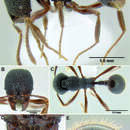Description
(
Inglês
)
fornecido por Zookeys
Worker description.
(21 measured) HL 0.90–1.20 (1.05), HW 0.77–1.15 (1.00), FLD 0.21–0.32 (0.29), PCW 0.04–0.07 (0.06), SL 0.75–1.01 (0.93), EL 0.09–0.13 (0.12), ACL 0.63–0.78 (0.72), ML 1.15–1.62 (1.45), PrW 0.52–0.78 (0.70), PSL 0.15–0.37, SDL 0.08–0.16, PL 0.45–0.64 (0.56), PH 0.21–0.35 (0.27), PW 0.15–0.24 (0.21), PPL 0.21–0.31 (0.26), PPH 0.18–0.28 (0.24), PPW 0.20–0.30 (0.27), MFL 0.81–1.25 (1.10), MTL 0.66–0.95 (0.88), CI 85–96 (96), SI 85–99 (88), REL 10–14 (12), FLI 25–31 (29), PSI 1.3–2.9 (2.3), MFI 86–105 (91), ACI1 62–65 (64), ACI2 78–89 (82).
Medium to large-sized species; general body color usually red-black (type population) to black, with patches of brown, but some populations more uniformly brown; mandibles and appendages always lighter than body, brown to orange-brown; setae golden brown; mandible with 4–8 teeth (usually 7), consisting of 3–4 distinct apical teeth, a basal tooth, and a variable number of inner teeth, which are often worn and indistinct; basal tooth usually of moderate size (type population), but sometimes more robust and projecting; basal margin of mandible straight to slightly sinuous, sometimes with a shallow, broad basal depression, but without a distinct notch or tooth; mandible mostly smooth and shining, with scattered piligerous punctae and a few lateral striae; median lobe of clypeus usually slightly produced and clearly visible in full-face view (type population), but sometimes becoming obliquely flattened and angled more dorsoventrally, making it less visible; anterior clypeal margin varying from having a shallow to deep median emargination (type population), to forming 4 distinct blunt teeth; median lobe usually with a pair of faint longitudinal carinulae that diverge toward anterior margin, apex of lobe with a faint to strong transverse carinula; posterior extension of clypeus between frontal lobes of relatively moderate width (PCW 0.04–0.07), with sides subparallel to hour-glass-shaped; frontal lobes average to slightly expanded outward (FLD 0.21–0.32, FLI 25–31), with underlying torular lobes always visible in full-face view; head in full-face view roughly oval shaped to subcircular (CI 85–97), with posterior margin slightly to distinctly depressed medially; eyes relatively small (EL 0.09–0.13, REL 10–14), circular, and somewhat bulging, with 5–7 ommatidia at greatest diameter; head foveate to coarsely rugoreticulate, shiny, often with a few short costae extending back from frontal lobes, interstices with piligerous punctae; scape relatively short, not reaching posterior margin of head when laid back (SI 85–99); scape shiny, usually with only scattered piligerous punctae (type population), but sometimes more robust, with punctae deeper and broader, becoming foveolae; flagellum with indistinct 4-segmented antennal club; mesosoma robust, foveate to coarsely rugoreticulate, with foveae most prominent on promesonotal dorsum; propodeal spines varying from short tubercles to long robust spines (PSL 0.15–0.37, PSI 1.3–2.9), which are usually spiniform and project dorsoposteriorly (type population), but sometimes form robust vertical pointing triangles; promesonotum in profile varying from being domed and nearly symmetrical (type population), to domed and asymmetrical, with apex occurring anterior of midpoint, to high-domed and asymmetrical; humeral angles rounded and indistinct, to becoming produced and angulate (type population), the latter occurring when the promesonotal side is scalloped slightly inward; metanotal grove present, but variable in depth and degree of distinctness; anterodorsal margin of propodeum in profile flat to distinctly raised into a welt (type population); propodeal declivity with a variable number of transverse carinae, often mostly smooth and shiny; petiole shape in profile usually appearing relatively long and somewhat gracile (PL/HW 0.53–0.63), with a small distinct node (PH/PL 0.45–0.55) (type population), but sometimes petiole is more robust and strongly wedge-shaped, without a clear distinction between the node and peduncle; postpetiole in profile usually low-domed, nearly symmetrical, and appearing as high or slightly smaller than petiolar node (type population), but sometimes postpetiole distinctly larger than petiolar node; postpetiole in dorsal view elongate, and reaching its widest point near posterior margin; waist sculpture variable, nodes usually mostly smooth and shiny, but sometimes more punctate and/or with longitudinal costae or rugulae, ventral surface punctate, dorsal surface of peduncle punctate and with a variable number of rugulae; gaster mostly smooth and shiny, with scattered piligerous punctae, and short furrows on anterior constriction where gaster inserts into postpetiole; most of body with relatively long standing pilosity; scape either with a single layer of mostly decumbent setae, or bilayered with a sparse layer of longer suberect setae over a denser decumbent layer (type population); gastral pilosity relatively long and somewhat dense, with most setae suberect to subdecumbent; setae on legs suberect to decumbent, with some populations having predominately suberect setae (type population) and others mainly decumbent setae, longer suberect setae always present on femoral venters and coxae.
Queen description.
(5 measured) HL 0.96–1.03 (1.03), HW 0.91–0.99 (0.99), FLD 0.26–0.29 (0.29), PCW 0.05–0.07 (0.06), SL 0.84–0.89 (0.89), EL 0.17–0.19 (0.17) ACL 0.68–0.72 (0.71), ML 1.47–1.57 (1.57), PrW 0.76–0.82 (0.82), PSL 0.18–0.28 (0.28), SDL 0.13–0.16 (0.13), PL 0.59–0.61 (0.60), PH 0.28–0.32 (0.31), PW 0.22–0.25 (0.24), PPL 0.27–0.33 (0.32), PPH 0.23–0.28 (0.28), PPW 0.25–0.31 (0.29), MFL 1.01–1.06 (1.06), MTL 0.79–0.85 (0.85), CI 93–97 (97), SI 86–94 (90), REL 17–20 (17), FLI 28–31 (29), PSI 1.1–2.1 (2.1), MFI 87–95 (93), ACI1 63–64 (63), ACI2 80–85 (80).
Same as worker except for standard queen modifications and the following: Propodeal spines less variable (PSL 0.18–0.28, PSI 1.1–2.1), usually present, of moderate length, and thick at base (only Nahá population with spines tuberculate); setae on scape less variable, usually with a sparse layer of longer suberect setae and a layer of denser decumbent setae (only Nahá population with setae uniformly subdecumbent); wing venation as in Figure 56D.
Male.
Unknown.
- licença
- cc-by-3.0
- direitos autorais
- Michael G. Branstetter
- citação bibliográfica
- Branstetter M (2013) Revision of the Middle American clade of the ant genus Stenamma Westwood (Hymenoptera, Formicidae, Myrmicinae) ZooKeys 295: 1–277
- autor
- Michael G. Branstetter


![]()